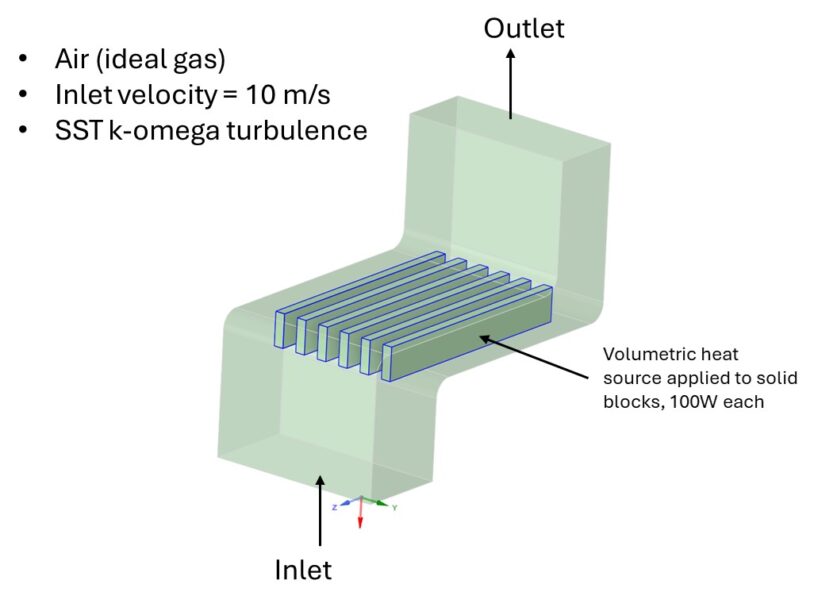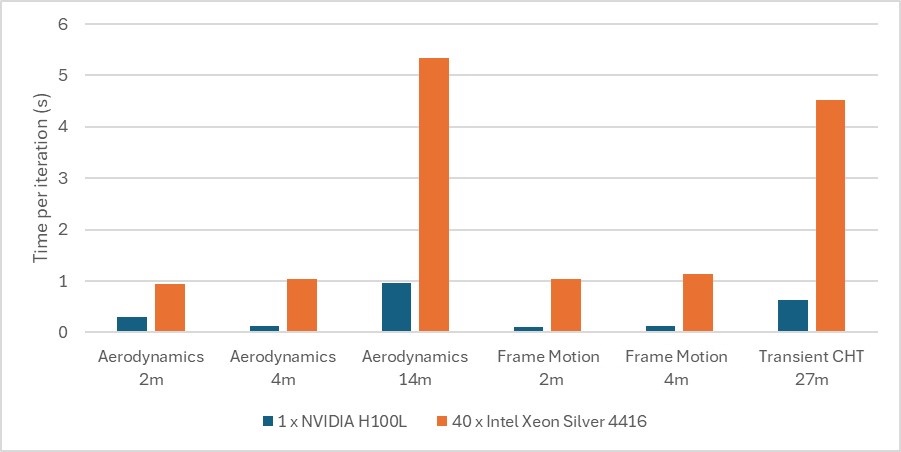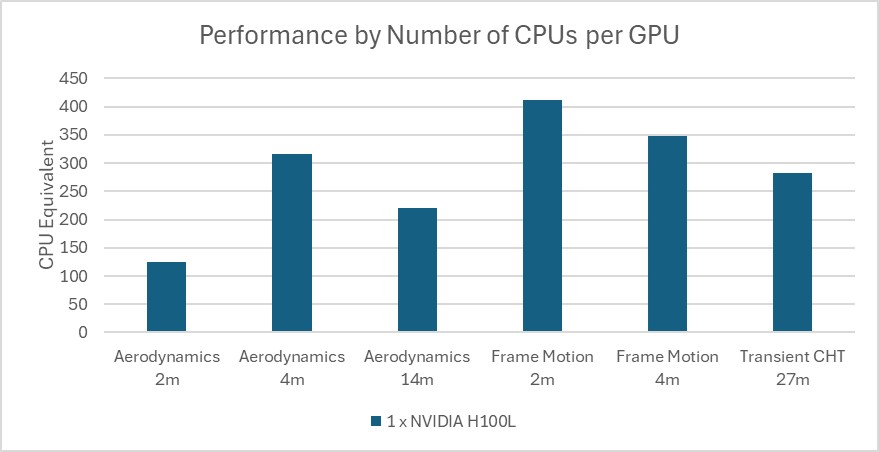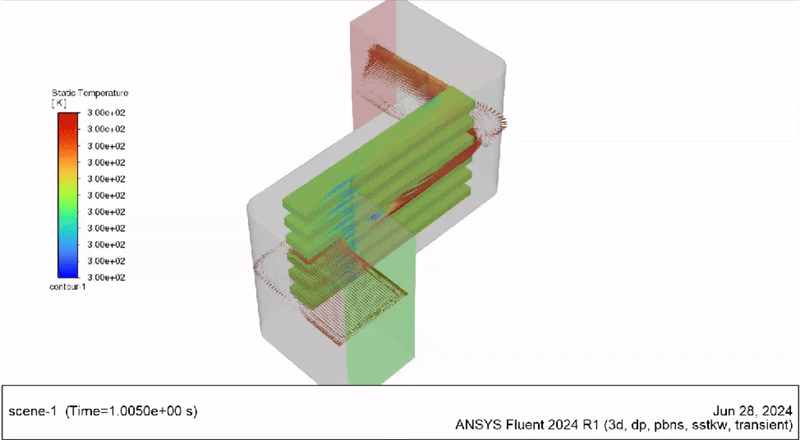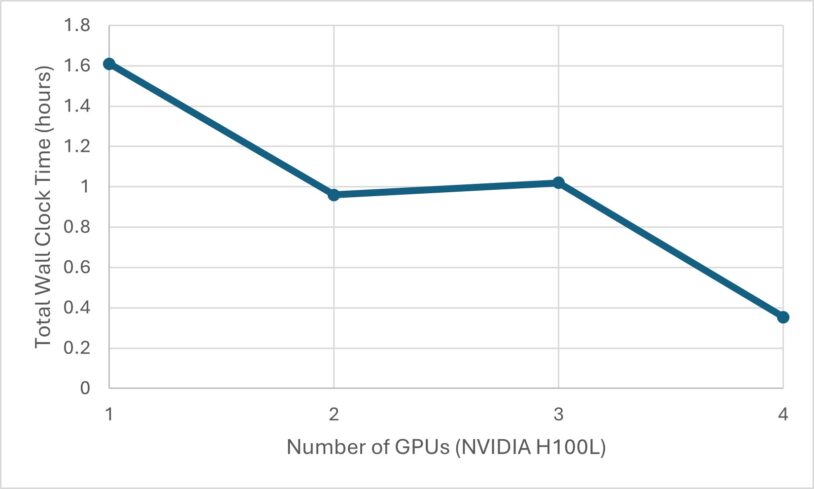Discover how GPU solvers outpace CPUs in engineering simulations with insights from our testing of NVIDIA’s technology and Exxact’s hardware.
Executive Summary
When our friends at NVIDIA offered us the chance to test the Ansys Fluent GPU solver on their cutting-edge hardware, we couldn’t resist accepting the challenge! Special thanks to Exxact Corp for setting up and configuring a workstation so that our SimuTech engineers could jump straight into testing. Our experiments showed that a single GPU can yield solve speeds equivalent to over 400 CPU-cores and reduce total energy consumption by 67%. In the coming years, GPU solvers have the potential to replace CPUs as the standard hardware for engineering simulation.
CPU vs GPU Simulation Hardware and Testing Conditions
The workstation supplied by Exxact Corporation for testing was equipped with two Xeon Silver 4416+ CPUs and four NVIDIA H100L GPUs. For testing purposes, only a single GPU card was utilized.
Fluent models included five steady-state test cases obtained from Ansys, with mesh sizes ranging from 2 million to 14 million elements. Steady-state physics included turbulent external aerodynamics and frame motion. A sixth test case was created by SimuTech to test the transient solver, which consisted of 27 million mesh elements and utilized SST k-omega turbulence, conjugate heat transfer, and compressible air as the working fluid. The transient geometry and simulated conditions are shown in Figure 1.
CPU vs GPU Performance Comparison
Figure 2 compares wall clock time per iteration between 40 CPUs versus a single GPU. Case names indicate both physics models and mesh count. For the external aerodynamics cases, the GPU solver performs between 3 to 10x faster than the CPU.
For cases involving frame motion, GPU performance gains were similar for both the 2 million and 4 million cell cases, yielding 10.3x and 8.7x speedup respectively.
Normalized Performance Metrics
To better generalize the performance gains, Figure 3 reports the solution speed in terms of CPU equivalent. CPU equivalency was calculated as:

A single GPU performs at an equivalent of 124 CPU-cores in the worst case (Aerodynamics 2m), and up to 412 CPU-cores in the best case (Frame Motion 2m).
Energy Consumption Benefits
When comparing CPU vs GPU simulation, in addition to faster solve times, GPU simulation can also reduce total hardware energy consumption. For the Transient CHT case, the GPU solve reduced hardware energy consumption by 67%. Performance data is summarized in Table 1. A solution animation is included in Figure 4.
| 1000 time steps, ∆t = 0.001s | ||
|---|---|---|
| Hardware | CPU – 40x Xeon Silver 4416+ | GPU – 1x NVIDIA H100L |
| Average time per iteration | 4.521s | 0.640s |
| Total simulation wall-clock time | 6.6 hours | 1.6 hours |
| Total energy consumption (CPUs + GPUs) | 2.32 kWh | 0.77 kWh |
Performance details for the Transient CHT 27m case.
Multi-GPU Performance
Like traditional CPU solvers, GPU cards can also be leveraged to operate in parallel. As a final experiment, multi-GPU solver performance was explored for the Transient CHT 27m case. Figure 5 compares the total simulation wall-clock time required to solve 1000 time steps using 1, 2, 3, and 4 GPUs.
Increasing the number of GPUs from two to four reduced total simulation time by 40% and 78%, respectively. In this case, solving on three GPUs offered no performance gains compared to solving on two.
From a software perspective, load distribution and mesh partitioning are known challenges in HPC performance for scaling CPU solves across multiple cores and processors. Despite the obvious advantages of GPU solvers, it would be unrealistic to expect they would be impervious to some non-linearity in scaling performance. As the technology continues to mature, hardware scalability will inevitably become more robust.
CPU vs GPU Simulation: Final Thoughts & the Future of GPU Solvers
In the test cases considered, a single GPU performed with solve speeds equivalent to over 400 CPU-cores. Performance gains can vary based on model size and physics. While the GPU solver does not yet support the full suite of Fluent physics models, more capabilities are added with each new release. In the coming years, GPUs have the potential to displace CPUs as the standard hardware for engineering simulation.
Ready to Accelerate Your Simulations? Contact Our Experts
Are your simulations ready for GPU acceleration? Schedule a call with one of our experts today!
About the Author

Jeff Collins, Ph.D.
CFD Staff Engineer, SimuTech Group
Jeff Collins holds a Ph.D. in Mechanical Engineering from Washington State University. At SimuTech Group, he focuses on computational fluid dynamics. Collins has several published articles and has in-depth experience in overset meshing, hydrodynamics, and heat transfer.
Related Content
Accelerate Ansys Workflows with SimuTech Group, NVIDIA, and Exxact
Discover how SimuTech, NVIDIA, and Exxact collaborate to deliver GPU-accelerated workstations that enhance productivity and streamline Ansys simulation workflows, driving faster and more efficient product development.
CFD Consulting Services
Reduce design failures and optimize product and component designs with computational fluid dynamics (CFD) and the engineering simulation experts at SimuTech Group.
Engineering & Simulation Webinars
View upcoming and on-demand webinars while learning about simulation software features, updates and best practices.
Industry Solutions
SimuTech Group provides industry-specific capabilities and expertise that deliver the flexibility and scalability you need for your specific projects.


